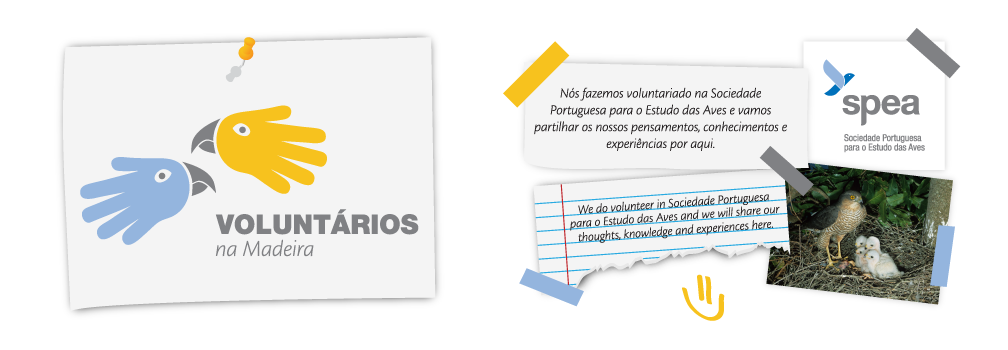Após duas semanas intensas, a campanha "Salve uma ave marinha" está agora a terminar. Esta campanha é realizada todos os anos para salvar os juvenis de cagarras que são atraídos e desorientados nas nossas cidades.
Durante esta campanha, 88 cagarras foram resgatadas. Infelizmente, 5 foram encontradas mortas. Esta campanha foi possível graças à participação de 62 voluntários (50 voluntários locais e 12 voluntários externos à região) .
Esta acção foi também uma oportunidade de sensibilização para as questões e impactos da poluição luminosa na biodiversidade e das acções levadas a cabo através do projecto LIFE Natura@Night.
Por conseguinte, foi oferecida uma série de sessões de formação e visitas guiadas aos voluntários ao longo da semana.
| Formação técnica: aves do arquipélago e metodologias de censos de aves. Foto: Tânia Costa |
| Formação técnica: Insetos da Madeira e métodos de amostragem. Foto: Elisa Teixeira |
| Visita guiada às instalações da Estação de Biologia Marinha do Funchal. Foto: Elisa Teixeira |
| Visita guiada ao Museu de História Natural do Funchal. Foto: Tânia Costa |
A fim de estudar a interação entre as aves marinhas e a iluminação nocturna, 19 rotas (transectos) foram pré-definidas e percorridas todas as noites pelos voluntários.
Estes cobriram a parte este da ilha da Madeira, de Câmara de Lobos a Santana (os municípios parceiros do projecto Life Natura@night). O total de 2240 km foram percorridos durante a campanha.
Cada ave encontrada foi colocada numa caixa de cartão e foram recolhidos os seguintes dados: identificação da ave, estado da ave (saudável, ferida ou morta), idade (adulta ou juvenil), presença de predadores, coordenadas GPS, intensidade da luz no local, metereologia.
Ao fim de cada noite, medições biométricas foram feitas (peso, medições de bico, asas, tarso e amostragem de penas).
Foram então anilhados antes de serem libertados ao longo da linha de costa. A fim de compreender o comportamento e interações dos indivíduos com a costa, dez cagarras foram equipados com GSM’s antes de serem libertados.
Quando os indivíduos eram feridos ou enfraquecidos, eram levados para o centro de recuperação da IFCN.
| Recolha de aves encontradas durante a campanha antes de serem libertadas. Foto: Tânia Costa |
| Medidas biométricas. Foto: Tânia Costa |
| Colocação de um dispositivo GSM numa cagarra. Foto: Elodie Crepin |
No futuro, esperamos encontrar soluções para reduzir o impacto da iluminação nas aves marinhas e, por conseguinte, diminuir o número de juvenis desorientados nas nossas cidades.
Até lá, o trabalho dos voluntários é mais do que essencial para assegurar a conservação das aves marinhas.
Esperamos vê-lo na nossa próxima campanha!
After two intense weeks, the campaign "Salve uma ave marinha" is now ending.
This campaign is conducted every year to save the juveniles of Cory's Shearwater that get lured and trapped in our cities.
During this campaign, 88 Cory's Shearwater were rescued. Unfortunately, 5 were found dead. This campaign was made possible thanks to the participation of 62 volunteers (50 local volunteers and 12 volunteers from outside the region).
This action was also an opportunity to raise awareness of the issues and impacts of light pollution on biodiversity and of the actions carried out through the LIFE Natura@night project. Therefore, a series of training sessions and guided tours were offered to the volunteers throughout the week.
| Technical formation: birds of the archipelago and methodologies of bird census. Picture: Tânia Costa |
| Technical formation: Insects of Madeira and sampling methods. Photo: Elisa Teixeira |
| Guided visit to the installations of the Marine Biology Station of Funchal. Picture: Elisa Teixeira |
| Guided visit to the Natural History Museum of Funchal. Picture: Tânia Costa |
In order to study the interaction between seabirds and night-time lighting, 19 routes (transects) were predefined and walked each night by the volunteers. These covered the East, from Câmara de Lobos to Santana (the partner municipalities of the Life Natura@night project). A total of 2240 km were walked during the campaign.
Each bird found was placed in a cardboard box and the following data were collected: bird ID, bird status (healthy, injured or dead), age (adult or juvenile), presence of predators, GPS coordinates, light intensity at the site, time.
At the end of each night's round, biometric measurements were taken (weight, measurements of beak, wings, tarsus and feather sampling). They were then ringed before being released along the shoreline. In order to understand the behaviour and interactions of the individuals with the shore, ten Cory's Shearwater were equipped with GSM before being released.
When individuals were injured or weakened, they were taken to the IFCN revalidation centre.
| Gathering of birds found during the campaign before being released. Picture: Tânia Costa |
| Biometric measurements. Picture: Tânia Costa |
| Placing of a GSM device on Cory's Shearwater. Picture: Elodie Crepin |
In the future, we hope to find solutions to reduce the impact of lighting on seabirds and therefore limit the number of juveniles disoriented and trapped in cities.
Until then, the work of volunteers is more than essential to ensure the conservation of seabirds.
We hope to see you in our next campaign!
